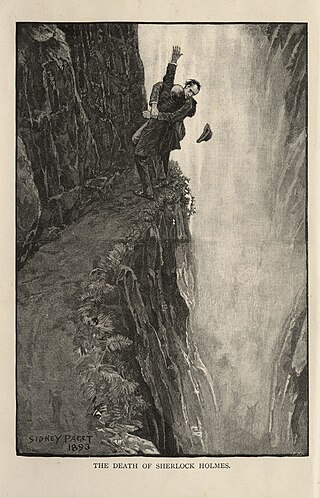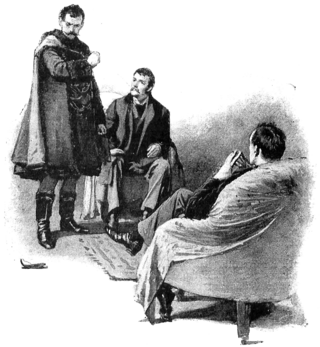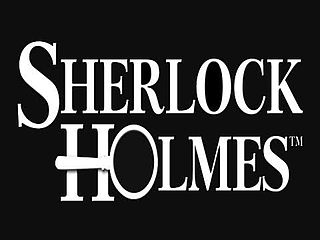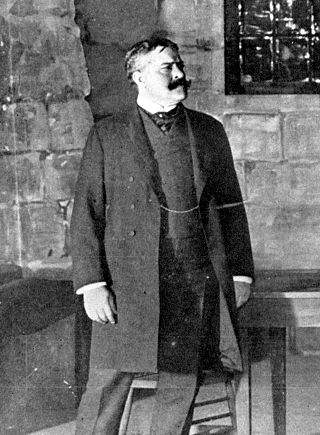
Professor James Moriarty is a fictional character and criminal mastermind created by Sir Arthur Conan Doyle to be a formidable enemy for the author's fictional detective Sherlock Holmes. He was created primarily as a device by which Doyle could kill Holmes and end the hero's stories. Professor Moriarty first appears in the short story "The Adventure of the Final Problem", first published in The Strand Magazine in December 1893. He also plays a role in the final Sherlock Holmes novel The Valley of Fear, but without a direct appearance. Holmes mentions Moriarty in five other stories: "The Adventure of the Empty House", "The Adventure of the Norwood Builder", "The Adventure of the Missing Three-Quarter", "The Adventure of the Illustrious Client", and "His Last Bow".

Mycroft Holmes is a fictional character appearing in stories written by Sir Arthur Conan Doyle from 1893 to 1908. The elder brother of detective Sherlock Holmes, he is a government official and a founding member of the Diogenes Club. Mycroft is described as having abilities of deduction and knowledge exceeding even those of his brother, though their practical use is limited by his dislike of fieldwork.

"The Final Problem" is a short story by Sir Arthur Conan Doyle featuring his detective character Sherlock Holmes. It was first published in The Strand Magazine in the United Kingdom, and McClure's in the United States, under the title "The Adventure of the Final Problem" in December 1893. It appears in book form as part of the collection The Memoirs of Sherlock Holmes.

"A Scandal in Bohemia" is the first short story, and the third overall work, featuring Arthur Conan Doyle's fictional detective Sherlock Holmes. It is the first of the 56 Holmes short stories written by Doyle and the first of 38 Sherlock Holmes works illustrated by Sidney Paget. The story is notable for introducing the character of Irene Adler, who is one of the most notable female characters in the Sherlock Holmes series, despite appearing in only one story. Doyle ranked "A Scandal in Bohemia" fifth in his list of his twelve favourite Holmes stories.

Arsène Lupin is a fictional gentleman thief and master of disguise created in 1905 by French writer Maurice Leblanc. The character was first introduced in a series of short stories serialized in the magazine Je sais tout. The first story, "The Arrest of Arsène Lupin", was published on 15 July 1905.
Moran is a modern Irish surname derived from membership of a medieval dynastic sept. The name means a descendant of Mórán. “Mor” in Gaelic translates as big or great and “an” as the prefix the. Morans were a respected sept of the Uí Fiachrach dynasty in the western counties of Mayo and Sligo. In Ireland, where the name descended from the Gaelic, it is generally pronounced MORR-ən anglicised approximate of the Irish pronunciation.

Colonel Sebastian Moran is a fictional character in the stories written by Arthur Conan Doyle. An enemy of Sherlock Holmes, he first appears in the 1903 short story "The Adventure of the Empty House". Holmes once described him as "the second most dangerous man in London", the most dangerous being Professor Moriarty, Moran's employer.
The stories of Sherlock Holmes by Sir Arthur Conan Doyle have been very popular as adaptations for the stage, and later film, and still later television. The four volumes of the Universal Sherlock Holmes (1995) compiled by Ronald B. De Waal lists over 25,000 Holmes-related productions and products. They include the original writings, "together with the translations of these tales into sixty-three languages, plus Braille and shorthand, the writings about the Writings or higher criticism, writings about Sherlockians and their societies, memorials and memorabilia, games, puzzles and quizzes, phonograph records, audio and video tapes, compact discs, laser discs, ballets, films, musicals, operettas, oratorios, plays, radio and television programs, parodies and pastiches, children's books, cartoons, comics, and a multitude of other items — from advertisements to wine — that have accumulated throughout the world on the two most famous characters in literature."
Sherlock Holmes has long been a popular character for pastiche, Holmes-related work by authors and creators other than Arthur Conan Doyle. Their works can be grouped into four broad categories:
Many writers make references to Sir Arthur Conan Doyle's famous literary creation, the detective Sherlock Holmes, and these often become embedded within popular culture. While Holmes exists predominantly in the context of Victorian-era London, he has been mentioned in such outre contexts as the 22nd century or hunting aliens or supernatural enemies. These references are in addition to the innumerable passing references to Sherlock Holmes made in many literary and cinematic works, such as the labeling of a person as a "Sherlock", whether in reference to their intelligence.

Sherlock Holmes and the Deadly Necklace is a 1962 mystery film directed by Terence Fisher. It is a West German-French-Italian international co-production. The film starred Christopher Lee as Sherlock Holmes and Thorley Walters as Dr. Watson. Curt Siodmak wrote the screenplay, based on characters created by Sir Arthur Conan Doyle.

Sherlock Holmes is a series of adventure games developed by Frogwares. The games are based on Arthur Conan Doyle's Sherlock Holmes stories, featuring the detective Sherlock Holmes and his companion Dr. John H. Watson. While the franchise is based on Doyle's stories, each game has an original plot and storyline.
Imagination Theatre is an American syndicated radio drama program airing on AM & FM radio stations across the United States. It features modern radio dramas. The program first aired in 1996. Originally produced by Jim French Productions, the program is now produced by Aural Vision, LLC.
The Game most commonly refers to:

Sherlock is a British mystery crime drama television series based on Sir Arthur Conan Doyle's Sherlock Holmes detective stories. Created by Steven Moffat and Mark Gatiss, the show stars Benedict Cumberbatch as Sherlock Holmes and Martin Freeman as Doctor John Watson. Thirteen episodes have been produced, with four three-part series airing from 2010 to 2017 and a special episode that aired on 1 January 2016. The series is set in the present day in which it aired, while the one-off special features a Victorian period fantasy resembling the original Holmes stories. Sherlock is produced by the British network BBC, along with Hartswood Films, with Moffat, Gatiss, Sue Vertue and Rebecca Eaton serving as executive producers. The series is supported by the American station WGBH-TV Boston for its Masterpiece anthology series on PBS, where it also airs in the United States. The series is primarily filmed in Cardiff, Wales, with North Gower Street in London used for exterior shots of Holmes and Watson's 221B Baker Street residence.

Silver Blaze is a 1937 British, black-and-white crime and mystery film, based loosely on Arthur Conan Doyle's 1892 short story "The Adventure of Silver Blaze". It was directed by Thomas Bentley, and was produced by Twickenham Film Studios Productions. It stars Arthur Wontner as Sherlock Holmes, and Ian Fleming as Dr. Watson. In the United States, the film was released in 1941 by Astor Pictures, where it was also known as Murder at the Baskervilles, retitled by distributors to capitalize on the success of the Basil Rathbone Holmes film, The Hound of the Baskervilles.
This article describes minor characters from the Sherlock Holmes stories by Sir Arthur Conan Doyle, and from non-canonical derived works. The list excludes the titular character as well as Dr. Watson, Professor Moriarty, Inspector Lestrade, Mycroft Holmes, Mrs. Hudson, Irene Adler, Colonel Moran, the Baker Street Irregulars, and characters not significant enough to mention.
"The Great Game" is the third and final episode of the first series of the television series Sherlock. It was first broadcast on BBC One and BBC HD on 8 August 2010. It was written by Mark Gatiss and directed by Paul McGuigan.

Professor James Moriarty is the fictional archenemy of Sherlock Holmes in some of the stories written by Sir Arthur Conan Doyle. He has appeared in several forms outside of the original stories.
"The Final Problem" is the third episode of the fourth series, and the series finale, of the British television series Sherlock, and the thirteenth episode overall. The episode first aired on BBC One, PBS, Channel One and 1+1 on 15 January 2017.










